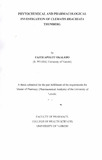| dc.contributor.author | Okalebo, Faith A | |
| dc.date.accessioned | 2013-05-10T08:27:33Z | |
| dc.date.available | 2013-05-10T08:27:33Z | |
| dc.date.issued | 2000 | |
| dc.identifier.citation | Master of Pharmacy (Pharmaceutical Analysis) | en |
| dc.identifier.uri | http://erepository.uonbi.ac.ke:8080/xmlui/handle/11295/21133 | |
| dc.description.abstract | The leaves, stem and roots of Clematis brachiata Thunberg
(Ranunculaceae) tested positive for anthraquinones, alkaloids,
saponins, coumarins, sterols, carotenoids and flavanoids and
cardenolides. Only the stem and leaves had tannins. The root had the
highest amounts of alkaloids and anthraquinones
The stem Soxhlet methanol extract yielded 13.2 mg (0.029 % of the
dried stem powder) of quercetrin (3-0-beta-L- rhamnosyl, 3', 4', 5, 7
tetrahydroxyl flavone). In addition the extract yielded 6400 mg
(1.3 % of dried stem powder) of a precipitate, FAO-FRS. It was
composed of a mixture of non-aromatic compounds.
The roots yielded 170 mg (0.068 % of dried root powder) of a nonaromatic
unsaturated lactone.
The Soxhlet methanol extracts of the leaves and stem had very good
activity against brine shrimps (LDso66.5 ug/ml and 365.6 ug/ml
respectively). An ethyl acetate ffaction of the stem Soxhlet extract,
FES, had the greatest activity against the-shrimps (LDso= 23.08
ug/ml).
The cold methanol extract of the root showed good in vitro
antimalarial activity (LDso = 39.9 ug/ml) against highly chloroquine
resistant isolate, Plasmodium falciparum VliS.
The leaf and stem extracts showed low in vitro antimalarial activity.
Quercetrin is known to have in vivo antimalarial activity.
None of the isolates and plant extracts showed significant
antimicrobial activity.
FAO-FRS, the cold methanol extracts of the leaf and stem showed
antinociceptive and local anesthetic effects.
The cold methanol extracts of the leaf, stem and roots caused
relaxation of the isolated rabbit ileum. At low concentrations, FAOFRS
caused relaxation of the isolated rabbit ileum and at high
concentration it had a dose dependent contractile effect.
The traditional use the leaves and stems of C. brachiata Thunb as
analgesics, local anesthetics, antimalarial agents and spasmolytics,
seems tv have sound scientific rationale. The traditional use of the roots for the management of malaria and as a purgative seems to have
scientific rationale. | en |
| dc.description.sponsorship | University of Nairobi | en |
| dc.language.iso | en | en |
| dc.title | Phytochemical and pharmacological investigation of clematis brachiata thunberg | en |
| dc.type | Thesis | en |
| dc.description.department | a
Department of Psychiatry, University of Nairobi, ; bDepartment of Mental Health, School of Medicine,
Moi University, Eldoret, Kenya | |
| local.publisher | Department of Pharmacology and Pharmacognosy, Faculty of Pharmacy, College of Health Sciences, University of Nairobi | en |

